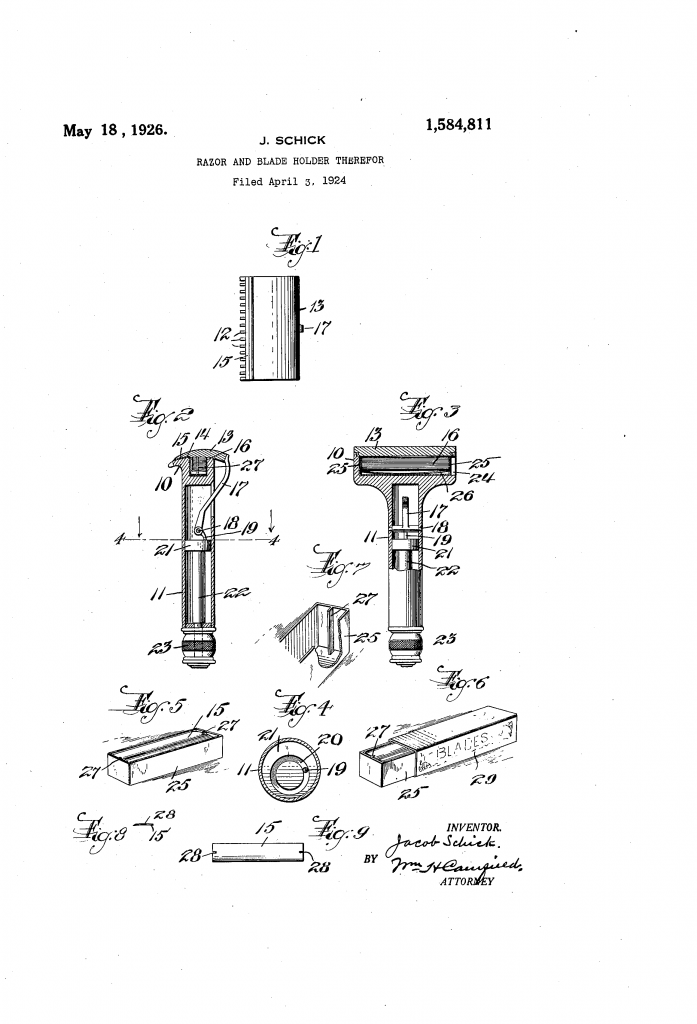Schick didn’t go directly from his first patent to the Type A. In between he patented a second repeating razor, that has a fair bit in common with the first patent.
Unlike the first patent, the second patent specifically mentions the use of a blade package. It extols the virtue of the package as a sanitary improvement. To quote:
The holder and the stack of blades in it form a unit that can be inserted into the razor without the user handling an individual blade either to in sort it in the holder or to place it in shaving position. The holder and the blades form an expendable unit so that the purchaser simply inserts the filled holder into the razor and after the blades are used up the holder is thrown away. This not only provides for economy in manufacture and saves time in using the razor, but it also guards against injury as the user need not handle an individual blade at any time.
Furthermore, this package insures a sanitary razor as when the packing of blades in a holder is done automatically the individual blades need not be handled by anyone from the time they are packed until they are used for shaving.
From US patent 1,584,811
Conceptually there is not that much difference between Jacob’s first and second repeating razor. On both you manipulated part of the razor to make the top cap move back and forth.
But the devil is in the details, as always.

Instead of twisting the handle back and forth, on the second patent you twisted the knob at the bottom. This moved – through a cam and a bell crank – the top plate back far enough that it would pick up a blade from the magazine. Twisting the knob further would cause the top plate would swing forward, ejecting the old blade and presenting a new one for use.
Or as the patent text puts it:
The means shown for operating the top plate consists of an arm 17 which is pivoted on a pin 18, this pivotal point being the center of the radius of the opposed faces of the top plate and the guard. The arm has an extension 19 which fits in a slot 20 in a collar 21 thus forming a cam on the end of the stem 22 the projecting end 23 of which is beyond the end of the handle and thus available for easy manipulation.
It will be seen from this that when the finger piece 23 is turned the cam groove 20 will actuate the finger 19 and this in turn swings the arm 17 which being secured to the top plate moves the top plate to the desired position. Suitable insignia can be placed on the finger piece or handle to indicate relative positions and directions of operation for placing the blade.
From US patent 1,584,811
There are three major improvements, as I see them, in Jacob’s second repeating razor.
Firstly, the mechanism is a fair bit neater. Gone are the rack and spur gears, replaced by a cam and a bell crank. The back and forth motion is replaced by a full rotation of the knob.
Secondly, the blades are kept in a carrier. This means that the shaver won’t have to manipulate a stack of thin, razor sharp razor blades.
And thirdly, it just looks better.
The downsides are much the same as in the first patent. The head don’t fold, meaning it is less suitable as a travel razor. And the blade magazine is right up by the wet end… which could cause carbon blades to rust. With modern stainless blades, the risk of corrosion is much reduced.
My only concern is that the short end of the bell crank that rides in the cam track looks a bit flimsy. Apart from that, I would buy this razor if someone manufactured it today.
You can read the full patent for Jacob’s second repeating razor at Google Patents.

Pingback: Schick's second repeating razor - Razors n Blades the shave that saves